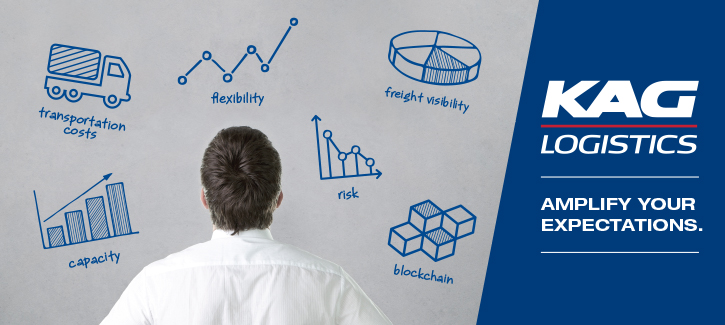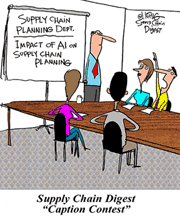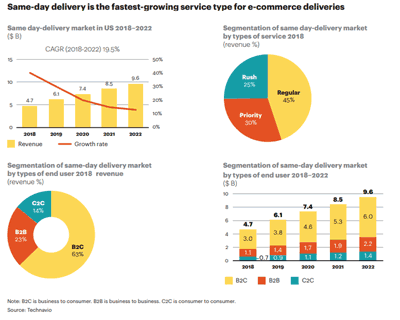State of the Logistics Union 2019 Part 2
Last week, I summarized the 2019 State of Logistics Report from CSCMP and lead authors from consulting firm ATKearney, released with much fanfare at the National Press Club in Washington DC a week ago Tuesday.
The report summarizes logistics spending and trends based on 2018 data.
The headline news is that US logistics spending rose an incredible 11.4% in 2018, to $1.64 trillion dollars, driven by rapidly rising trucking costs.
| GILMORE SAYS: |
The report says that 5G will also accelerate the US of processes controlled by artificial intelligence, and enable development of "highly customized logistics services."
WHAT DO YOU SAY?
Send us your
Feedback here
|
On a relative basis, "US Business Logistics Costs," or USBLC in an acronym unlikely to become part of the industry lexicon any time soon, rose to 8.0% of US GDP, up significantly from 7.5% in 2017 and the highest level since 2014.
You can find a lot more of the numbers in my column from last week - see State of the Logistics Union 2019.
But the report goes beyond all the numbers, looking each year at various trends that accompany the quantitative results. So I thought this week I would summarize some of this year's thinking here.
There is quite a bit of commentary naturally enough on the impact of ecommerce and efulfillment on the logistic sector. That impact has obviously been transformational, and the sector is being roiled again by the rise of same-day deliveries.
The report includes a nice set of charts showing many dimensions of the same-day phenomenon, as you see below, with for example same day growing to a projected $10 billion market by 2022.
The report also contains a good section on blockchain in the supply chain, and thankfully provides a realistic assessment, versus much of the hype seen from other commentators.
"Millions of dollars have been invested in blockchain over the past few years, and millions more are expected," the report notes (more like tens of millions). It adds that despite these investments—and the hype that has existed since its launch—blockchain technology has yet to take off."
Blockchain in theory could transform the flow of supply chain information. As the report notes, the promise of blockchain technology is that a fully transparent transaction ledger could drastically improve data transparency and data sharing, thus overcoming some of the greatest inefficiencies in logistics today.
"A blockchain-powered network could seamlessly show where goods came from (addressing provenance and authenticity issues), where they were going (improving payments and border crossings), and where they are now (providing real-time tracking)," the report notes.
Because it would be instantaneous and immutable, a blockchain would be more trustworthy than today's blizzard of processes and paperwork (though I note it really can't prevent supply chain fraud).
Yet, the report notes that logistics and transportation companies have been slow to adopt this technology. The reasons are many, but perhaps most important is the need for a robust network of companies willing and able to make the move.
"A meaningful blockchain ledger needs to be accessible to and used by all players - shippers, carriers, and regulators, and companies large and small. And like all networks, it only drives value when many are participating, leaving such questions in supply chain about how such a network develops, who takes the lead, will large companies be willing to decentralize, and whether smaller players see sufficient benefit to join up? And perhaps most critically, can the industry get competitors to work together to build a truly universal network?
I personally have some questions about just how much information "lead" companies are going to share. Does Walmart really want all it's supply chain partners to know how many containers it is moving where? I don't think so. Yet many blockchain proponents seem to believe this cross supply chain visibility will be the end state.
All of which leaves individual companies in a tough spot regarding blockchain. Walmart can certainly create its own blockchain ecosystem, sharing no more than any individual company participant needs to know (if anything). But if you are Acme Widgets, there is not much you can do until the Walmarts of the world ask you to comply with their requirements - with perhaps little value in return.
So when will blockchain in logistics take off in a meaningful way?
The report says it will take the following developments:
Creation of common standards for interoperability of data, such as GS1 standards for EDI, so as to prevent today's physical supply chain barriers from becoming tomorrow's digital barriers.
Ensuring confidentiality of member data, thus incentivizing more companies to join the network and increase its value.
Arriving at a tipping point in the blockchain network, when a sufficient number of early and mainstream adopters force the rest of the mainstream and late adopters to get on board or risk being left behind.
In other words: It's going to take a while.
Perhaps surprisingly, the report also looks at the coming impact on logistics of so-called 5G wireless standard and technology.
The speed of this new wireless technology, the report says, is such you could download 20 movies in the time it takes to access one under current 4G systems. Batteries attached to sensors will somehow last 10 years instead of one by harnessing network energy.
So that's great for consumers. How would that have an impact on logistics?
Well, the report notes the radically improved data speeds and the ability of 5G to break data communications into more distributed pipe should dramatically improve the performance and safety of autonomous cars and trucks.
Maybe they really are coming.
The report says 5G could also have an impact in areas such as use of video in some chain processes (think for example of instantaneous video training), use of virtual reality, enabling more dense sensor networks, better control of robots, and more.
The report contains a nice chart showing the short and longer term impacts of 5G on operational execution, planning and management, and other services that I don't have room for here, but will use as SCDigest's Supply Chain Graphic of the week in two weeks.
The chart, for example, says that 5G will also accelerate the US of processes controlled by artificial intelligence, presumably by enabling more floor-level input into the AI machine. Or consider development of "highly customized logistics services," such as temperature monitored parcel deliveries, or event-driven logistics services.
Among the other impacts the report sees from 5G is improved end-to-end view of the supply chain.
"The eventual spread of 5G and anticipated large appetite for adoption will lead to many ecosystem entrants with thousands of applications in this space - finally creating the opportunity for an end-to-end view of the entire supply chain," the report says, adding that "With the large, inflexible ERP systems of the past, it would have been cost-prohibitive to instrument an entire supply chain, if such a task were even possible. Connecting all elements of the supply chain would be laudable but impossible. But because 5G offers the ability to more flexibly connect all elements and providers throughout the supply chain, this vision can finally become a reality."
This is actually a very good section of the report, and well worth the read.
Hope you enjoyed these two columns on the State of Logistics Report 2019. I will be off next week for one of the four times all year.
Any reaction to our summary of this year's State of Logistics? What do you think of blockchain or 5G and logistics? Let us know your thoughts at the Feedback button below. |



![]()

![]()

![]()

![]()










